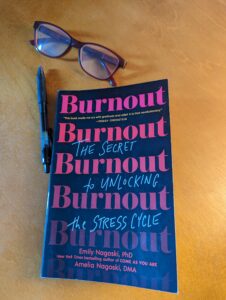
19 April 2024
Let’s talk about burnout
In 2020, like most of us, I began a number of online activities. One of which was participating in a couple different online Book Clubs. We were not going out after work, we were not traveling on weekends and yet most of us were still craving connection – book club virtual style became a thing.
One of the books I read that year was “Burnout: The Secret to Unlocking the Stress Cycle,” written by sisters Emily and Amelia Nagoski. I was familiar with Emily’s work, having referred countless patients to her famous work of nonfiction, “Come as you Are: The Surprising New Science That Will Transform Your Sex Life.” (I might be moved to post on the latter at some future date.) And I loved it, what I’ll now refer to as “the Burnout book” if that’s okay.
I think I loved the Burnout book partly because I had just left a job for a new job, left my city for a new city, and yet simultaneously was still running, (and losing) a race against burnout myself. I was tired of the way we do healthcare, while still fueling a passion to serve my community. I felt this internal pressure to start doing things differently. I also didn’t really know how to change any of these external things and make them stick, instead of just replacing them with new, shiny ways to practice being the best “human giver*” I could be.
One of the observations I have made, while working one-on-one with patients who struggle with issues affecting the pelvic floor, is how much being a compassionate listener can help break a cycle of suffering. And rather than focusing on “fixing” someone’s bodily structures, how being a highly informed educator, and a connector of resources who helps people build their team of support can be the best way to really treat things like chronic pain.
I have discovered over the years that I love teaching people about our nervous systems, and how they affect our movement patterns, our motivation, and our obstacles to goal attainment. And like most passion projects, I love it because I’ve lived it.
I learned how to recognize signs of burnout, in my career as well as my personal life, by learning how to slow down and track my own nervous system. I credit this most recently to studying, practicing and receiving Craniosacral Therapy (CST), specifically Biodynamic CST. And I also love other pathways to a balanced nervous system such as yoga, meditation, exercise and simply connecting and playing with others (which was sorely missed during the lock-down period for many of us.)
As important as recognition might be, in noting the state of your nervous system, just as crucial is taking action. And most of the time this becomes a much more doable task with some support.
If you have read this far, and are curious about nervous system education, pelvic health, craniosacral therapy or just like a good small group discussion I’d love for you to connect with me for an upcoming free webinar/online get together. I plan on a short presentation on how I include nervous system work in my sessions, and a short Q&A. Details to be posted soon!
*“Human givers are expected to offer their time, attention, affection, and bodies willingly, placidly, to the other class of people, the “human beings.”
Manne, Kate. Down Girl. Penguin Books, 2019.
Nagoski, Emily, and Amelia Nagoski. Burnout: The Secret to Unlocking the Stress Cycle. First edition. New York, Ballantine Books, 2019.
